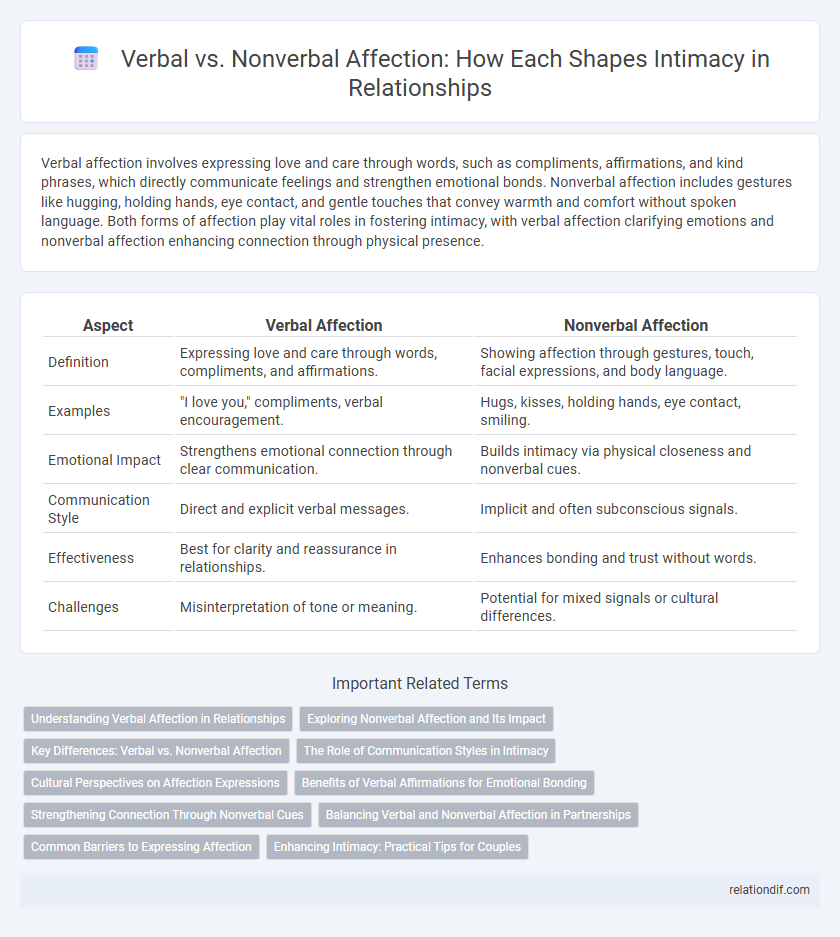Verbal affection involves expressing love and care through words, such as compliments, affirmations, and kind phrases, which directly communicate feelings and strengthen emotional bonds. Nonverbal affection includes gestures like hugging, holding hands, eye contact, and gentle touches that convey warmth and comfort without spoken language. Both forms of affection play vital roles in fostering intimacy, with verbal affection clarifying emotions and nonverbal affection enhancing connection through physical presence.
Table of Comparison
| Aspect | Verbal Affection | Nonverbal Affection |
|---|---|---|
| Definition | Expressing love and care through words, compliments, and affirmations. | Showing affection through gestures, touch, facial expressions, and body language. |
| Examples | "I love you," compliments, verbal encouragement. | Hugs, kisses, holding hands, eye contact, smiling. |
| Emotional Impact | Strengthens emotional connection through clear communication. | Builds intimacy via physical closeness and nonverbal cues. |
| Communication Style | Direct and explicit verbal messages. | Implicit and often subconscious signals. |
| Effectiveness | Best for clarity and reassurance in relationships. | Enhances bonding and trust without words. |
| Challenges | Misinterpretation of tone or meaning. | Potential for mixed signals or cultural differences. |
Understanding Verbal Affection in Relationships
Verbal affection in relationships involves expressing love, appreciation, and care through spoken or written words, which helps partners feel valued and emotionally connected. This form of affection enhances communication by clarifying feelings and strengthening trust, often addressing emotional needs that nonverbal cues alone may not convey. Consistent verbal affirmation contributes to higher relationship satisfaction by reducing misunderstandings and reinforcing emotional intimacy.
Exploring Nonverbal Affection and Its Impact
Nonverbal affection includes physical touch, eye contact, and facial expressions, which play a crucial role in building emotional closeness. These nonverbal cues often convey feelings more powerfully than words, enhancing intimacy and trust between partners. Research shows that consistent nonverbal affection contributes to higher relationship satisfaction and deeper emotional bonds.
Key Differences: Verbal vs. Nonverbal Affection
Verbal affection involves expressing love and care through spoken words or written messages, such as compliments, declarations, and affectionate conversations, which provide clear and direct communication of emotions. Nonverbal affection relies on physical gestures like hugs, kisses, eye contact, and touch, conveying intimacy and emotional connection without language. The key difference lies in verbal affection's reliance on explicit expression, while nonverbal affection depends on subtle, physical cues to foster closeness and emotional bonding.
The Role of Communication Styles in Intimacy
Verbal affection, expressed through spoken or written words, conveys emotions directly and reinforces emotional bonds by articulating love, appreciation, and support. Nonverbal affection, including physical touch, eye contact, and facial expressions, communicates feelings subtly and often strengthens intimacy by creating a sense of safety and connection. Understanding and aligning communication styles in both verbal and nonverbal forms enhances emotional closeness, mutual understanding, and relationship satisfaction.
Cultural Perspectives on Affection Expressions
Cultural perspectives shape how verbal affection, such as spoken compliments and expressions of love, contrasts with nonverbal affection like physical touch and eye contact, influencing intimacy dynamics across societies. In collectivist cultures, nonverbal affection often dominates due to indirect communication norms, while individualistic cultures emphasize explicit verbal expressions to convey emotional closeness. Understanding these cultural variations enhances interpersonal communication and strengthens intimate relationships by respecting diverse affection paradigms.
Benefits of Verbal Affirmations for Emotional Bonding
Verbal affirmations play a crucial role in strengthening emotional bonds by explicitly expressing love, appreciation, and support, which fosters trust and security in relationships. Unlike nonverbal affection, verbal affirmations reduce misunderstandings by clearly communicating feelings and intentions, enhancing emotional clarity between partners. Consistent verbal expressions of affection boost self-esteem and deepen intimacy, creating a resilient foundation for long-term connection.
Strengthening Connection Through Nonverbal Cues
Nonverbal affection, such as hugging, eye contact, and gentle touches, plays a crucial role in strengthening intimacy by conveying emotions that words often cannot express. These nonverbal cues deepen emotional bonds and enhance feelings of safety, trust, and understanding between partners. Consistent physical gestures foster a profound connection that reinforces verbal expressions of love and affection.
Balancing Verbal and Nonverbal Affection in Partnerships
Balancing verbal and nonverbal affection in partnerships fosters deeper intimacy and trust by addressing diverse emotional needs. Verbal affection, such as compliments and expressions of love, clarifies feelings, while nonverbal cues like touch and eye contact convey warmth and security beyond words. Prioritizing both forms enhances communication, ensuring partners feel valued and emotionally connected.
Common Barriers to Expressing Affection
Common barriers to expressing verbal affection include fear of vulnerability, lack of emotional vocabulary, and cultural norms discouraging explicit emotional expression. Nonverbal affection often faces challenges such as personal discomfort with physical touch, misinterpretation of gestures, and situational constraints like public settings or social norms. Overcoming these barriers enhances intimacy by fostering clearer emotional communication and deeper connection.
Enhancing Intimacy: Practical Tips for Couples
Verbal affection, such as expressing love and appreciation through words, significantly strengthens emotional bonds and fosters open communication between partners. Nonverbal affection, including gestures like hugs, eye contact, and gentle touches, conveys love and comfort beyond spoken language, enhancing feelings of security and closeness. Couples can boost intimacy by combining consistent verbal affirmations with mindful nonverbal cues, creating a balanced and deeply connected relationship.
Verbal affection vs Nonverbal affection Infographic

 relationdif.com
relationdif.com